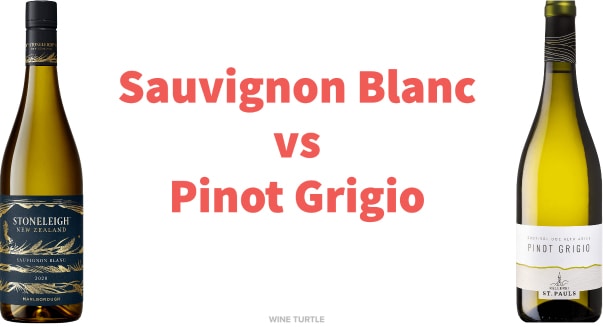Sauvignon Blanc and Pinot Grigio are two of the most popular white wines in the world, often appreciated for their light bodies and refreshing acidity. However, despite some similarities, they differ significantly in flavor profile, aroma, and ideal pairings, making them appealing to different palates and occasions.

Table of Contents
Sauvignon Blanc vs Pinot Grigio/Sauvignon Blanc Versus Pinot Grigio/Sauvignon Blanc vs Pinot Gris: Flavor Profiles and Aromas
Sauvignon Blanc is known for its bright, zesty flavor and distinct aromatic character. The wine often showcases notes of grapefruit, lime, green apple, and passionfruit, and it frequently has a herbaceous edge, such as fresh-cut grass or green bell pepper. These characteristics are especially pronounced in Sauvignon Blanc from regions like Marlborough in New Zealand, which has become famous for producing particularly vibrant and fruit-forward expressions of the grape. In contrast, Sauvignon Blanc from France’s Loire Valley tends to be more restrained, with flinty, mineral undertones that offer a more earthy experience.
Pinot Grigio, on the other hand, typically presents a more subtle flavor and aroma profile. It leans toward notes of green apple, pear, lemon, and sometimes white peach, with floral hints and a crisp, clean finish. Italian Pinot Grigio—especially from the Veneto or Alto Adige regions—is usually very light, dry, and refreshing. French Pinot Gris, which is the same grape under a different name, can be richer and occasionally off-dry, offering more body and depth. While Sauvignon Blanc tends to be bold and assertive, Pinot Grigio is more delicate and neutral, making it an easy choice for casual sipping.
Sauvignon Blanc vs Pinot Grigio/Sauv Blanc vs Pinot Grigio/Sauvignon Blanc Wine vs Pinot Grigio: Acidity and Body
Both wines are high in acidity, which contributes to their refreshing qualities and ability to pair well with food. However, Sauvignon Blanc generally has a more pronounced sharpness due to its often tangier citrus and green fruit notes. Its acidity tends to be mouthwatering, giving the wine a crisp and invigorating feel.
Pinot Grigio’s acidity is still present but often feels a bit softer and smoother on the palate. This makes it a great choice for those who find Sauvignon Blanc a bit too intense. Both wines are typically light-bodied, though Pinot Grigio can sometimes have a slightly fuller mouthfeel, particularly in expressions from warmer climates or richer Pinot Gris styles.
Pinot Grigio vs Sauvignon Blanc: Food Pairings
Sauvignon Blanc is a great match for foods that echo its bright, herbaceous qualities. It pairs well with dishes featuring fresh herbs, green vegetables, and tangy cheeses—especially goat cheese.
It’s also excellent with seafood like oysters, white fish, or shrimp, and it can hold up to dishes with a citrusy or vinegary bite, such as ceviche or salads with vinaigrette.
What Is Sauvignon Blanc?
Sauvignon blanc wine comes from a green-skinned grape variety that originates from the Bordeaux region of France (fun fact: Sauvignon Blanc is the parent grape of Cabernet Sauvignon grapes, which make the famous red wine).
Sauvignon blanc is planted in many of the world’s wine regions, producing a crisp, dry, and refreshing white varietal wine.
It offers a bold punch of acidity and can range from tropically fruity to green and herbaceous to earthy and flinty.
READ ALSO: Alors on Danse Meaning & More
What Is Pinot Grigio?
Pinot grigio, or pinot gris, is a white wine grape variety that normally has grayish-blue fruit, hence its name (grigio and gris are the word ‘gray’ in Italian and French, respectively).
Photo credits: WineTurtle